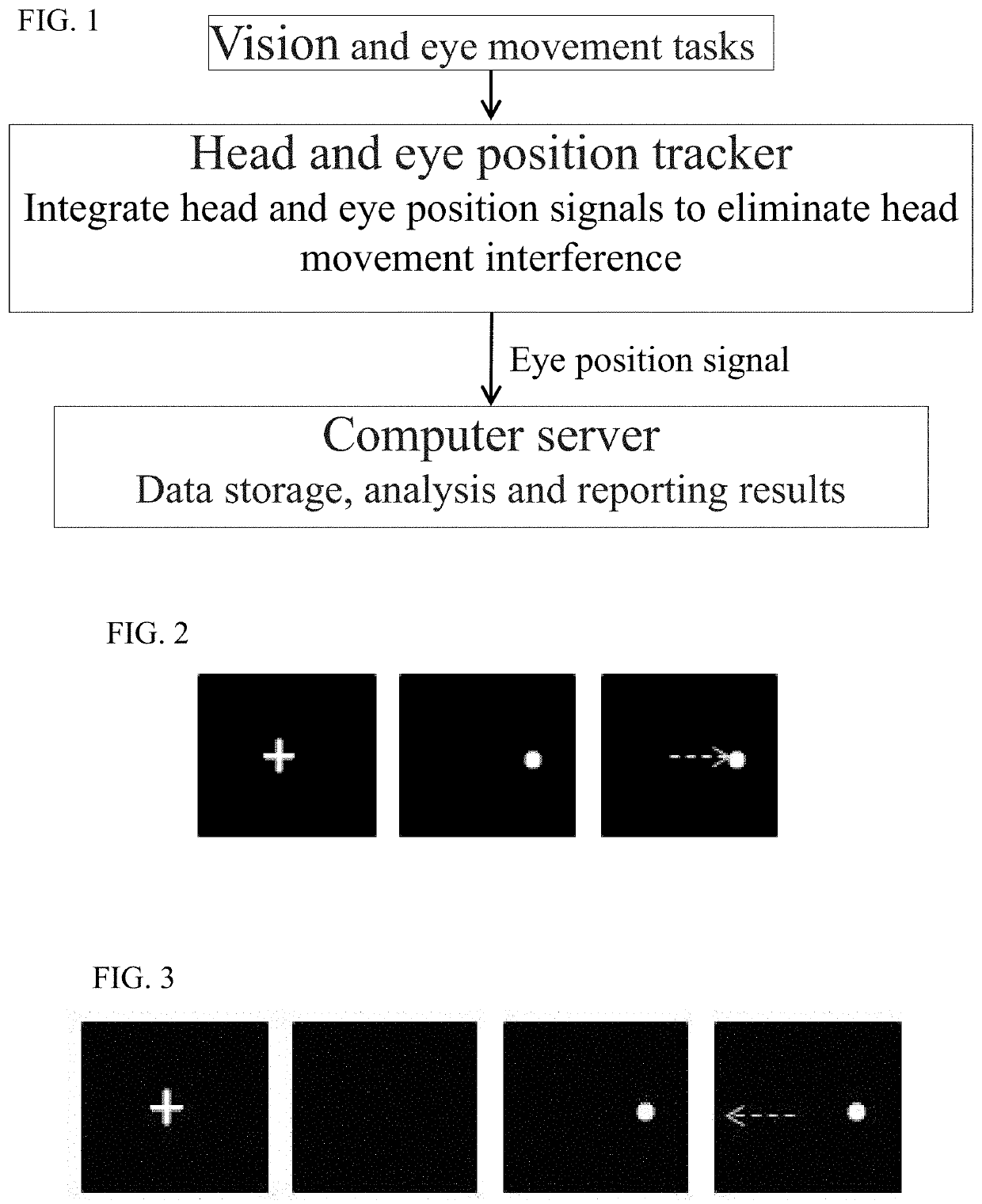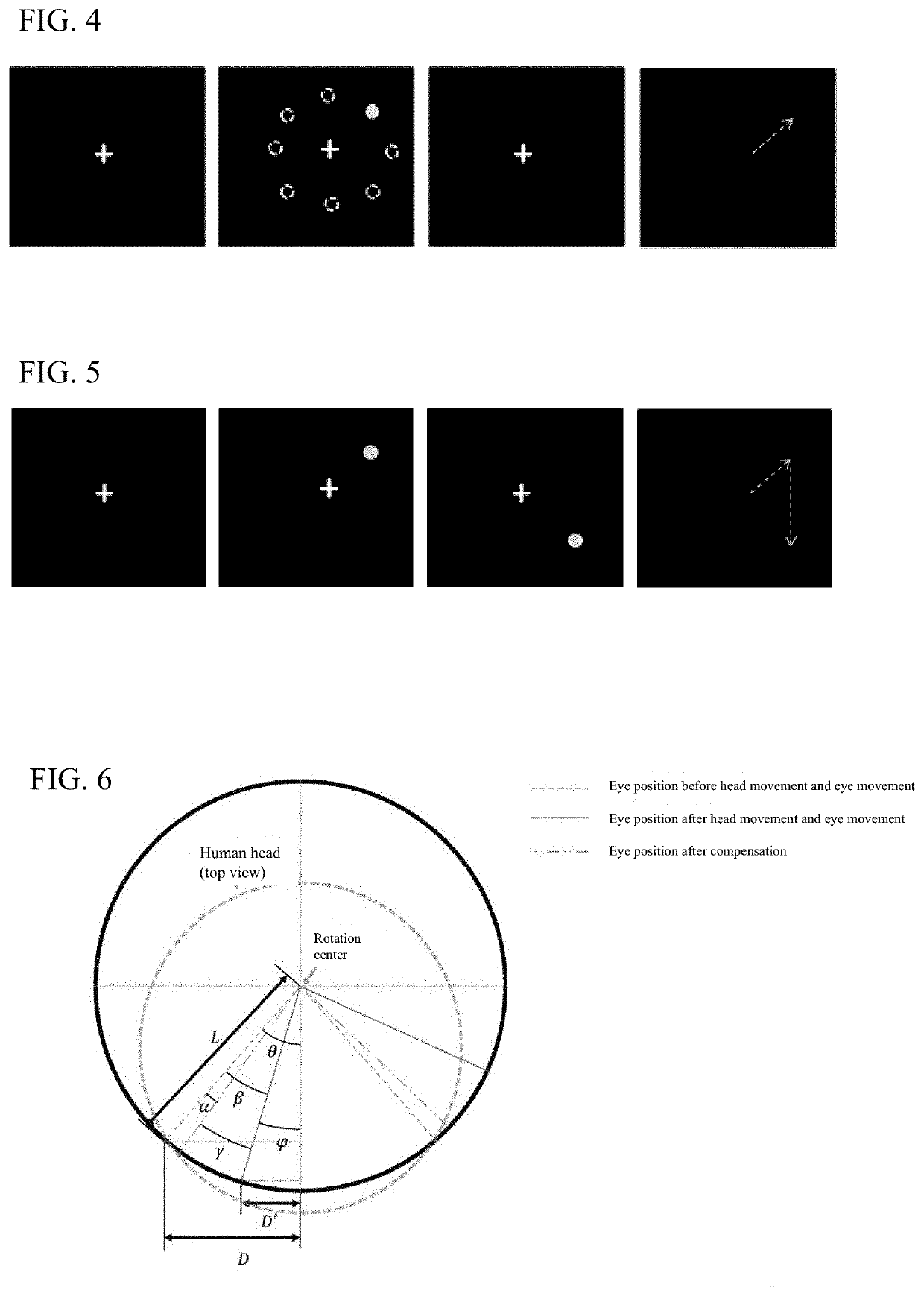Brain Function Testing System and Device Thereof
- Summary
- Abstract
- Description
- Claims
- Application Information
AI Technical Summary
Benefits of technology
Problems solved by technology
Method used
Image
Examples
example 1
Analysis System and Device Based on Brain Degenerative Diseases
[0168]The example specifically comprises the following modules (FIG. 1)
[0169]1) Experimental environment control module or device: to eliminate the impact of the experimental environment (including light brightness, noise level, etc.) on saccades;
[0170]2) A head fixation device may be further included to avoid large movements of the subject's head during data collection;
[0171]3) Vision and saccade task module or device: to collect eye and head position signals and pre-process them under specific behavior tasks (FIGS. 2 to 5);
[0172]4) Data collection module or device: for real-time collection of eye position signals through a near-infrared fast camera (1000 Hz), real-time collection of head position signals (200 Hz) through a head-mounted inclinometer, real-time analysis and processing of head, position signals, and compensation for the effect of head movement on eye positions (FIG. 3). The adopted calculation method is: ...
example 2
ent Parameters of Alzheimer's Disease and Parkinson's Disease Patients
[0180]By using the saccade analysis system and device of the present invention, it is verified that the system can accurately distinguish between patients with neurodegenerative diseases and normal people:
[0181](1) Different neurodegenerative diseases can cause specific changes in eye movement parameters in the four aforementioned behavioral paradigms. As follows:
[0182]Alzheimer's Disease (AD): Increased gaze instability; increased saccade latency and variability; decreased saccade velocity, increased error rate of saccade direction and precise time of anti-saccade task and memory-saccade task; decreased anti-saccade correction.
[0183]Parkinson's Disease (PD): Decreased voluntary eye movement gain (such as insufficient stretching); there are obvious defects in the initiation of memory-saccades and anti-saccades; inhibition of saccade amplitude can be detected early in PD, and may be related to basal ganglia functio...
example 3
ection
[0192]One subject sought clinical help because of paroxysmal mild tremor of the limb. Clinical examination found that the patient's other nervous system detection indicators were within the normal ranges, the brain magnetic resonance scan results were normal, and clinical diagnosis was difficult. The clinicians performed the aforementioned four eye-movement task tests for the patient and listed the experimental results in the control group (as opposed to patients with apparent PD and AD). However, when we analyzed the data, we found that many of the eye movement parameters of the subject were significantly different from those of other control subjects and were closer to the test results of PD and AD patients (FIGS. 21-24 and 27-29). Based on this, the clinician followed up the subject and carried out a number of clinical tests for 3 months, and the current initial diagnosis is essential tremor (suspected Parkinson's disease). FIGS. 21-24 show the saccadic traces of the subjec...
PUM
 Login to View More
Login to View More Abstract
Description
Claims
Application Information
 Login to View More
Login to View More - R&D
- Intellectual Property
- Life Sciences
- Materials
- Tech Scout
- Unparalleled Data Quality
- Higher Quality Content
- 60% Fewer Hallucinations
Browse by: Latest US Patents, China's latest patents, Technical Efficacy Thesaurus, Application Domain, Technology Topic, Popular Technical Reports.
© 2025 PatSnap. All rights reserved.Legal|Privacy policy|Modern Slavery Act Transparency Statement|Sitemap|About US| Contact US: help@patsnap.com



